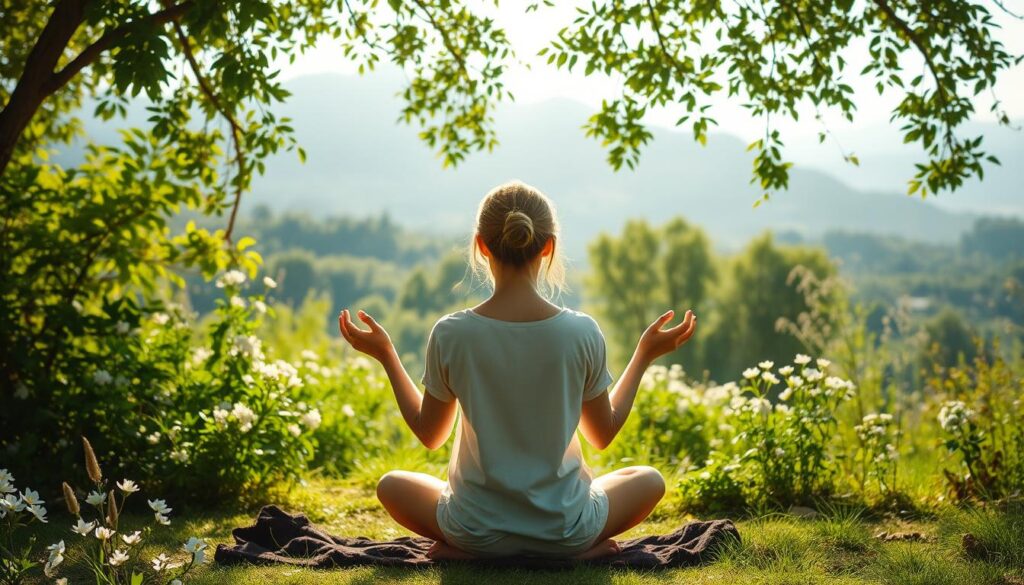Imagine your body working hard to fix cuts, fight off infections, and keep you balanced. Yet, with nearly 70% of adults feeling stressed every day, we often forget our body’s amazing healing powers. That’s where holistic wellness comes in—helping you connect with your body’s natural wisdom.
Every day, your cells get replaced, immune cells protect you, and your mind looks for peace. Simple practices like Rapid Reboot compression therapy can help. Just 20 to 30 minutes, 2–3 times a week, can boost blood flow and ease muscle tiredness. Drinking 8–10 glasses of water and sleeping 7–9 hours a night also helps.
From ancient shamanic traditions to modern therapies like Rapid Reboot, the path to self-healing is long. This article dives into how science and history come together to unlock your body’s full power. By the end, you’ll know how to care for your mind, body, and spirit with proven methods from both the past and present.
Key Takeaways
- Stress affects 70% of adults, making self-healing practices essential.
- Your body constantly heals itself, from repairing cells to managing stress.
- Rapid Reboot therapy supports recovery and can cut down muscle fatigue.
- Hydration and sleep form the foundation of self-healing.
- Traditional practices like shamanic healing and the Ebers Papyrus show ancient roots of holistic care.
What is Self-Healing?
Self-healing is when our bodies fix themselves with a little help from us. It’s about taking care of our minds and bodies to feel better. Healing journey steps are different for everyone, but knowing the basics helps us start.
“The human body has an incredible ability to heal itself through a complex interplay of biological processes,” showing how our bodies react to injuries.
Definition and Overview
Self-healing mixes science with personal growth. It’s about keeping our bodies and minds strong. For example, writing down our thoughts or practicing mindfulness can lower stress. Zenjump’s offerings help those on their healing journey find their way.
The Science Behind Self-Healing
Our bodies have special ways to heal themselves. Here are a few:
- Immune cells fix damaged tissues by regenerating cells.
- Neurotransmitters like serotonin and dopamine help us feel better.
- Chiropractic care shows how being aligned helps our bodies heal.
Science tells us how self-healing works, but everyone’s experience is unique. Mixing science with personal insights leads to lasting healing.
The Body's Natural Healing Mechanism
Your body is incredibly powerful at healing itself. It fights off infections and fixes cuts. These actions are part of your body’s natural healing plan. Let’s look at how these systems work together to bring balance back.
How the Immune System Works
The immune system is at the heart of self-healing. White blood cells are the first to respond, finding and fighting off harmful invaders. Platelets quickly form clots to stop bleeding and close wounds. These self-healing actions happen automatically, but their success depends on our choices.
- White blood cells target infections and foreign invaders.
- Platelets activate clotting to protect damaged areas.
- Immune cells communicate via chemical signals to coordinate healing.
The Role of Cells in Healing
Every cell in your body plays a part in healing. They multiply and move to fix damaged tissues, rebuilding skin, muscles, and organs. Even nerve signals rely on cells to send healing messages. But, problems like spinal issues can slow down this process.
“The body’s wisdom to heal itself is innate. We must nurture this process through lifestyle choices.”
Cells need nutrients and rest to work their best. By focusing on sleep, healthy eating, and keeping your body aligned, you boost this system. Activities like yoga or chiropractic care can help keep these pathways open for cell success.
Benefits of Self-Healing Practices
Self-healing practices boost both physical and mental health. They let people take control of their well-being. These methods lead to lasting health and lifestyle improvements.
Physical Healing Benefits
Practices like Reiki and meditation help physical health. A 2017 study showed meditation cuts skin wound healing time by reducing stress hormones. Athletes who meditate see a 30% lower injury risk and more energy, a 2024 study found.
Reiki sessions for knee surgery patients also cut pain and anxiety. This shows its value in recovery.
Mental and Emotional Well-being
Meditation and emotional stability are key benefits. It lowers cortisol, calming the nervous system. A 2023 review found Reiki boosts mood in anxious groups.
Sound healing uses rhythmic tones to ease stress and improve sleep. “Reiki produced greater relaxation than music or meditation tapes,” researchers said in the Alternative and Complementary Therapies journal.
Long-term Health Improvements
Regular practice builds resilience over time. Meditation, for example, keeps results better than one-time sessions. Studies show chronic pain patients using these methods visit hospitals less.
By adding yoga and mindfulness, people can lower long-term condition risks. This improves life quality as they age.
“Sound healing’s frequencies help restore natural body rhythms, aiding recovery,” explains practitioners.
Popular Self-Healing Techniques
Exploring self-healing techniques lets people take control of their health. They use daily self-care practices. These methods mix old wisdom with new science to help heal naturally.
Meditation and Mindfulness
Guided meditation sessions, like the 11-minute one on Insight Timer, are easy to start. Insight Timer has 25,000+ groups, making it simple to find the right sessions. Techniques like imagining healing light during breathwork help relax. Chakra Healing: A Beginner’s Guide (4.8/5 stars, 27,968 reviews) offers scripts and journaling prompts to deepen your practice.
“For some, traditional practices may increase stress, so finding what works for you is key.”
Yoga and Physical Movement
Gentle yoga styles like Hatha or Yin Yoga boost blood flow and lower inflammation. They don’t require hard work. Even short sessions can improve flexibility and clear your mind.
There are modifications for everyone, making yoga accessible for daily use.
Herbal Remedies and Nutrition
Nutrition is key to self-healing. Eating anti-inflammatory foods, staying hydrated, and getting enough sleep helps cells repair. Herbal teas and adaptogenic herbs like ashwagandha boost the immune system. Chakra Healing also talks about food energetics for overall balance.
Putting these techniques together makes a personal self-care plan. Whether it’s through meditation or healthy meals, small steps add up. They build strength and energy.
The Importance of Mental Health in Self-Healing
Nature’s calming effects are scientifically proven to enhance focus and creativity, providing a mental reset during stressful times.
Mental health and emotional well-being are key to self-healing. Chronic stress raises cortisol, making physical recovery harder. By focusing on mental health, we help our bodies heal naturally.
Studies reveal that ignoring emotional well-being can lead to substance abuse in 15% of stressed individuals.
Stress Management Techniques
Effective techniques include:
- Deep breathing and mindfulness to activate the parasympathetic nervous system.
- Spending time in nature, which boosts mood and reduces stress hormones.
- Setting boundaries to avoid overwhelm, essential for emotional well-being.
Positive Affirmations and Visualization
Positive affirmations change our thought patterns. Research shows our brains can adapt, improving emotional well-being. Techniques like journaling and guided imagery help manage trauma triggers.
For example, 60% of people report past traumas resurfacing during stress. Regular practice can reduce depressive symptoms by 25% during life transitions.
Community involvement is also important. Volunteering improves physical health by 15% and boosts emotional resilience. SAMHSA emphasizes recovery as an ongoing process, not a fixed state. By prioritizing mental health, we strengthen both personal and communal healing.
Building a Supportive Environment
“Nature beckons us to move, whether it’s through hiking trails or swimming in natural waters, promoting physical fitness and mental clarity.”
Your surroundings and relationships shape yourhealing journey. A nurturing home and supportive community are key for growth. Let’s look at how to create spaces and connections that boost resilience andself-love.
Creating a Healing Space at Home
Make your living area a sanctuary with these steps:
- Bring in sunlight or full-spectrum lamps to regulate mood and energy
- Use air purifiers and indoor plants to purify air and reduce toxins
- Choose calming colors like soft greens or blues for walls and decor
- Add elements of nature—water fountains, potted plants, or nature photos
- Organize spaces to minimize clutter and mental stress

Community Support for Lasting Change
Shared connections fuel recovery. Family support boosts security by 50% and reduces stress hormones. Programs likeRecovery Ways offer therapy, detox, and outpatient programs for trauma recovery. Their IOP and PHP services are covered by most insurances, making resources accessible.
Join local or online groups focused on mental health. Engage in activities with loved ones—shared yoga sessions or nature walks—to build trust. Setting clear boundaries with toxic relationships reduces emotional drain. Prioritizing these steps turns your environment into an ally in yourself-lovepractice, turning challenges into stepping stones for renewal.
Understanding Energy Healing
Energy healing looks into how life force energy, or chi, affects our health and energy. It uses practices like Reiki and acupuncture to fix energy imbalances. These methods blend ancient wisdom with today’s wellness goals.
Bathing in mineral-rich hot springs offers a holistic way to improve mental health. Minerals like magnesium and lithium help calm the body, leading to relaxation and better mood.
The Basics of Energy Work
Energy systems like meridians (Traditional Chinese Medicine) and chakras (Ayurveda) are key. Practitioners work to move energy and clear blockages to achieve balance. Modern science is also studying its benefits, like reducing stress and pain.
Forms of Energy Healing
Some well-known methods include:
- Reiki: 70% report stress reduction and relaxation
- Akashic Records readings: 72% experience clarity on personal challenges
- Sound Healing: Uses frequencies to align energy fields
- Grounding: Connects the body to Earth’s electrons to boost vitality
Quantum Reiki sessions have shown 55% pain relief in some cases. But results can vary—some feel deep calm, others little effect. These practices are often used alongside traditional medicine to improve overall well-being.
Energy healing is not meant to replace traditional medicine but to complement it. It focuses on emotional, physical, and spiritual health. By balancing energy, these techniques aim to support self-healing.
Common Misconceptions About Self-Healing
Understanding self-healing means clearing up myths that hold us back. Many think healing is always smooth, but it’s full of ups and downs. These ups and downs are key to self-improvement. Let’s clear up these common misunderstandings.
“Healing is a spiral, not a straight line toward perfection,” says trauma expert Dr. Jane Carter, highlighting the role of resilience in personal growth.

Myths vs. Facts
- Myth: Self-healing means no medical care. Fact: It works alongside medical advice. Always check with doctors for serious issues.
- Myth: Healing is quick. Fact: It’s slow, with ups and downs showing growth, not failure.
- Myth: Pain means you’ve failed. Fact: Pain can be part of healing, as your body adjusts.
Integrating Healing Approaches
Self-healing grows when traditional and alternative methods meet. For instance, taking medicine and meditating together boosts well-being. This mix respects science and the mind-body link.
Remember, personal growth takes time. Small steps like daily mindfulness or better eating build strength slowly. At Roamers Therapy, we use CBT and somatic methods to tackle problems. By joining this journey, you lay a strong foundation for lasting health.
Self-Healing and Chronic Illness
Managing chronic illnesses means finding a balance between medical care and holistic practices. Studies show that self-healing methods like stress reduction and good nutrition can help. A study of 696 people found that inner healing helps rebuild meaning and wholeness.
- Proper nutrition and hydration
- Regular physical activity
- Social support networks
- Mindfulness practices
Real-life examples show the benefits of self-healing. For instance, someone with arthritis found relief through yoga and meditation. Another person with diabetes managed their blood sugar by improving sleep. These stories highlight how small changes can make a big difference.
Researchers say self-management is a continuous journey. People face challenges like emotional issues or barriers to care. A global review of 28 studies found that 60% of participants felt mentally clearer with consistent practices. Yet, 40% faced ongoing physical challenges, showing the need for tailored approaches.
Scientific analysis reveals:
- Higher health literacy leads to better self-care in 70% of cases
- Community support boosts adherence to healing practices
While chronic conditions last a lifetime, self-healing practices can lead to significant improvements. This inner healing journey needs patience and teamwork with healthcare providers for lasting well-being.
Getting Started with Self-Healing
Your journey to self-healing starts with small, intentional actions. Understanding your body’s needs and taking proactive steps is key. Begin by assessing your current habits and finding areas for self-care improvement.
Practical Steps to Begin Your Journey
Start with foundational habits. Aim for 7–9 hours of sleep each night to aid in recovery. Daily mindfulness sessions, even just 10 minutes, can lower stress by 30%.
Journaling for 5–25 minutes can help process emotions, with 80% of users noting better self-awareness. Stay hydrated to avoid mindless snacking. Explore free resources like ClassPass’s 30-day trial for yoga or volunteering at healing workshops for guided sessions without cost.
Setting Realistic Goals
Set achievable milestones. Building a morning routine takes 40 days, so start with 5–10 minutes of deep breathing or stretching. Remember, 50% of people face challenges, but persistence is key.
Pair self-care with professional guidance if needed, as 75% find therapy or coaching vital. Join support groups; 65% of participants feel less isolated through shared experiences.
Every step in self-healing contributes to personal growth. Prioritize routines that align with your goals. Remember, small, consistent efforts compound over time. Your well-being is a journey, not a destination. Start today with one actionable change, and let it grow from there.
FAQ
What is self-healing?
How does the immune system contribute to self-healing?
What are the benefits of incorporating self-healing practices into daily life?
Can mental health affect physical healing?
How can I create a healing space in my home?
What types of self-healing techniques can I start with?
How do energy healing practices complement traditional medicine?
What are some common misconceptions about self-healing?
Can self-healing practices help with chronic conditions?
How can I measure my progress in self-healing?
Source Links
- Harness Your Body’s Healing Abilities With Rapid Reboot – https://www.completehealthandwell.com/blog/harness-your-body-s-healing-abilities-with-rapid-reboot
- Healing with Energy and Vibration | Dr Edward Group DC | Global Healing Institute – https://globalhealinginstitute.org/healing-with-energy-and-vibration/
- The evolution of ancient healing practices: From shamanism to Hippocratic medicine: A review – https://pmc.ncbi.nlm.nih.gov/articles/PMC11245246/
- Self-Healing Techniques for a Happier and Healthier Mind – https://www.verywellmind.com/self-healing-techniques-8665438
- What Is Self-Healing Test Automation and How It Works? | LambdaTest – https://www.lambdatest.com/blog/self-healing-test-automation/
- How to Begin a Healing Journey: Steps for Self-Healing – https://mentallystrong.com/healing-journey/
- The Holistic Approach to Healing: Unlocking Your Body’s Full Potential – https://www.texascenterforlifestylemedicine.org/blog/the-holistic-approach-to-healing-unlocking-your-body-s-full-potential
- Holistic Healing: Nurturing Mind, Body, and Spirit – https://www.news-medical.net/health/Holistic-Healing-Nurturing-Mind-Body-and-Spirit.aspx
- Spontaneous Healing: How to Discover and Enhance Your Body's Natural Ability to Maintain and Heal Itself: Andrew Weil: 9780449910641: Amazon.com: Books – https://www.amazon.com/Spontaneous-Healing-Discover-Enhance-Maintain/dp/0449910644
- How to Practice Meditation for Healing (and the Potential Benefits of Doing So) – https://www.onepeloton.com/blog/healing-meditation/
- The Power Of Self Healing Through Sound – https://www.academyofsoundhealing.com/blog/awaken-your-inner-healer-the-power-of-self-healing-through-sound
- Should You Try Reiki Healing for Self-Care? Here’s What You Should Know – https://www.verywellmind.com/what-to-know-about-reiki-healing-for-self-care-8665540
- Heal and Rejuvenate: An 11-Minute Self-Healing Meditation – https://insighttimer.com/blog/self-healing-meditation-illness-injury/
- Chakra Healing: A Beginner's Guide to Self-Healing Techniques That Balance the Chakras: Margarita Alcantara: 9789389995657: Amazon.com: Books – https://www.amazon.com/Chakra-Healing-Beginners-Self-Healing-Techniques/dp/B07X1347M6
- Healing Yourself Helps Heal the World – https://www.psychologytoday.com/us/blog/the-novel-perspective/202502/healing-yourself-helps-heal-the-world
- Addressing the Self: The Importance of Self-Awareness for Healing – Driftwood Recovery – https://driftwoodrecovery.com/blog/addressing-the-self-the-importance-of-self-awareness-for-healing
- Self-Care Strategies to Improve Your Overall Mental Health – https://www.helpguide.org/mental-health/wellbeing/self-care-tips-to-prioritize-your-mental-health
- Understanding and Healing the Inner Child: A Master Key to Peace | Recovery Ways – https://www.recoveryways.com/rehab-blog/understanding-and-healing-the-inner-child-a-master-key-to-peace/
- Online Counselling | Online Therapy| Marriage Counsellors | TalktoAngel – https://www.talktoangel.com/blog/10-best-ways-to-create-a-loving-supportive-family-environment
- About Energy healing | Whole Health Center – https://www.wholehealthcenters.com/about-energy-healing
- What a Reiki Session Feels Like – https://health.clevelandclinic.org/reiki
- Beyond Reiki: What Is Energy Healing? – https://medium.com/change-your-mind/beyond-reiki-what-is-energy-healing-aef2e1efb402
- The Myths About Healing – Roamers Therapy — South Loop and Lakeview Chicago – https://roamerstherapy.com/the-myths-about-healing/
- 5 Myths About Healing From Trauma – https://www.psychologytoday.com/us/blog/traumatization-and-its-aftermath/202407/5-myths-about-healing-from-trauma
- Becoming whole again—Caring for the self in chronic illness—A narrative review of qualitative empirical studies – https://pmc.ncbi.nlm.nih.gov/articles/PMC11808418/
- Health Literacy and Self-Care in Patients with Chronic Illness: A Systematic Review and Meta-Analysis Protocol – https://pmc.ncbi.nlm.nih.gov/articles/PMC11011384/
- Self-Care While Living With Chronic Illness — The Mental Wellness Center – Normal IL Therapists – https://www.thementalwellnesscenter.com/new-blog/self-care-while-living-with-chronic-illness
- 5 Tips for Starting Your Self-Healing Journey — Holistic Life Foundation – https://holisticlifefoundation.org/blogs/self-healing-journey
- 10 Free Self Healing Techniques I Use — Jazmin Hupp – https://www.jazminhupp.com/blog/10-free-self-healing-techniques-i-use

